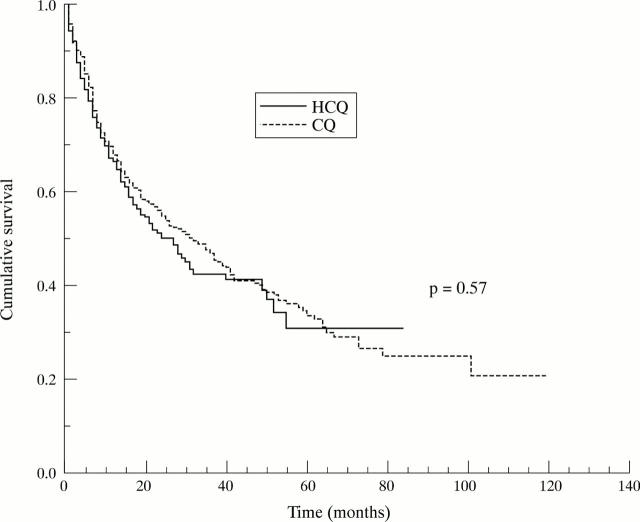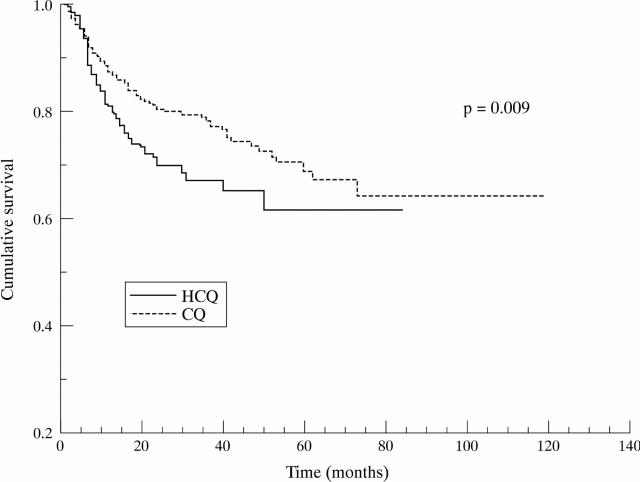Abstract
OBJECTIVE—The purpose of this study was to compare the long term effectiveness between chloroquine (CQ) and hydroxychloroquine (HCQ). METHODS—Medical charts of all patients seen by eight rheumatologists practising in two tertiary care centres and starting antimalarial treatment between January 1985 and December 1993 were reviewed. Patient characteristics, disease, and treatment information were collected. The main outcome measures were the cause of and the time to the discontinuation of antimalarial drugs resulting from all causes, principally toxicity or inefficacy, or both. Bivariate analysis including t tests and χ2 tests were used to assess differences between means and proportions respectively. Survival curves were evaluated using the Kaplan-Meier method. Multivariate analysis (Cox regression) was used to adjust for potential confounders. RESULTS—After all medical records were reviewed, 1042 eligible cases were identified. From these, 940 (90%) had usable information and they represent the cohort. Five hundred and fifty eight had rheumatoid arthritis, 178 had systemic lupus erythematosus, 127 had palindromic arthritis, and 77 had other diagnoses. Fifty seven per cent of the patients received CQ and 43% HCQ. The proportion of patients with side effects taking HCQ and CQ was 15% and 28% respectively (p=0.001). Using Cox regression model to adjust for age at the onset of antimalarial treatment, physician differences, sex, disease type, disease duration before treatment, and rank selection, there were no differences in the hazard ratio (HR) for overall discontinuations between CQ and HCQ. While the HR for discontinuations because of toxicity was lower for HCQ (HR= 0.6, 95% CI 0.4, 0.9), the HR for discontinuations because of inefficacy was significantly higher for HCQ (HR= 1.4, 95% CI 1.1, 1.9). CONCLUSIONS—After adjusting for time and several confounders HCQ was less toxic but less effective than CQ. Only one case of probable/possible retinopathy was found. Therefore, we propose a careful baseline ophthalmological evaluation by an expert and then one or every two years if proper doses are used. Keywords: antimalarial drugs; long term effectiveness; efficacy; toxicity; rheumatic diseases
Full Text
The Full Text of this article is available as a PDF (132.8 KB).
Figure 1 .
Kaplan-Meier curves for any cause of discontinuation of treatment.
Figure 2 .
Kaplan-Meier curves for discontinuation of treament because of toxicity.
Figure 3 .
Kaplan-Meier curves for discontinuation of treatment because of inefficacy.
Selected References
These references are in PubMed. This may not be the complete list of references from this article.
- Antimalarial workshop. J Rheumatol. 1997 Jul;24(7):1393–1395. [PubMed] [Google Scholar]
- Avina-Zubieta J. A., Johnson E. S., Suarez-Almazor M. E., Russell A. S. Incidence of myopathy in patients treated with antimalarials. A report of three cases and a review of the literature. Br J Rheumatol. 1995 Feb;34(2):166–170. doi: 10.1093/rheumatology/34.2.166. [DOI] [PubMed] [Google Scholar]
- Bellamy N., Brooks P. M. Current practice in antimalarial drug prescribing in rheumatoid arthritis. J Rheumatol. 1986 Jun;13(3):551–555. [PubMed] [Google Scholar]
- Easterbrook M., Bernstein H. Ophthalmological monitoring of patients taking antimalarials: preferred practice patterns. J Rheumatol. 1997 Jul;24(7):1390–1392. [PubMed] [Google Scholar]
- Felson D. T., Anderson J. J., Meenan R. F. The comparative efficacy and toxicity of second-line drugs in rheumatoid arthritis. Results of two metaanalyses. Arthritis Rheum. 1990 Oct;33(10):1449–1461. doi: 10.1002/art.1780331001. [DOI] [PubMed] [Google Scholar]
- Finbloom D. S., Silver K., Newsome D. A., Gunkel R. Comparison of hydroxychloroquine and chloroquine use and the development of retinal toxicity. J Rheumatol. 1985 Aug;12(4):692–694. [PubMed] [Google Scholar]
- Galindo-Rodriguez G., Avina-Zubieta J. A., Fitzgerald A., LeClerq S. A., Russell A. S., Suarez-Almazor M. E. Variations and trends in the prescription of initial second line therapy for patients with rheumatoid arthritis. J Rheumatol. 1997 Apr;24(4):633–638. [PubMed] [Google Scholar]
- Hawley D. J., Wolfe F. Are the results of controlled clinical trials and observational studies of second line therapy in rheumatoid arthritis valid and generalizable as measures of rheumatoid arthritis outcome: analysis of 122 studies. J Rheumatol. 1991 Jul;18(7):1008–1014. [PubMed] [Google Scholar]
- Kammer G. M., Soter N. A., Gibson D. J., Schur P. H. Psoriatic arthritis: a clinical, immunologic and HLA study of 100 patients. Semin Arthritis Rheum. 1979 Nov;9(2):75–97. doi: 10.1016/s0049-0172(79)80001-3. [DOI] [PubMed] [Google Scholar]
- Landewé R. B., Vergouwen M. S., Goeei The S. G., Van Rijthoven A. W., Breedveld F. C., Dijkmans B. A. Antimalarial drug induced decrease in creatinine clearance. J Rheumatol. 1995 Jan;22(1):34–37. [PubMed] [Google Scholar]
- Levy G. D., Munz S. J., Paschal J., Cohen H. B., Pince K. J., Peterson T. Incidence of hydroxychloroquine retinopathy in 1,207 patients in a large multicenter outpatient practice. Arthritis Rheum. 1997 Aug;40(8):1482–1486. doi: 10.1002/art.1780400817. [DOI] [PubMed] [Google Scholar]
- Mackenzie A. H. Dose refinements in long-term therapy of rheumatoid arthritis with antimalarials. Am J Med. 1983 Jul 18;75(1A):40–45. doi: 10.1016/0002-9343(83)91269-x. [DOI] [PubMed] [Google Scholar]
- Maksymowych W., Russell A. S. Antimalarials in rheumatology: efficacy and safety. Semin Arthritis Rheum. 1987 Feb;16(3):206–221. doi: 10.1016/0049-0172(87)90023-0. [DOI] [PubMed] [Google Scholar]
- Mavrikakis M., Papazoglou S., Sfikakis P. P., Vaiopoulos G., Rougas K. Retinal toxicity in long term hydroxychloroquine treatment. Ann Rheum Dis. 1996 Mar;55(3):187–189. doi: 10.1136/ard.55.3.187. [DOI] [PMC free article] [PubMed] [Google Scholar]
- Olson N. Y., Lindsley C. B. Adjunctive use of hydroxychloroquine in childhood dermatomyositis. J Rheumatol. 1989 Dec;16(12):1545–1547. [PubMed] [Google Scholar]
- PAGE F. Treatment of lupus erythematosus with mepacrine. Lancet. 1951 Oct 27;2(6687):755–758. doi: 10.1016/s0140-6736(51)91643-1. [DOI] [PubMed] [Google Scholar]
- Richter J. A., Runge L. A., Pinals R. S., Oates R. P. Analysis of treatment terminations with gold and antimalarial compounds in rheumatoid arthritis. J Rheumatol. 1980 Mar-Apr;7(2):153–159. [PubMed] [Google Scholar]
- Rynes R. I., Krohel G., Falbo A., Reinecke R. D., Wolfe B., Bartholomew L. E. Ophthalmologic safety of long-term hydroxychloroquine treatment. Arthritis Rheum. 1979 Aug;22(8):832–836. doi: 10.1002/art.1780220805. [DOI] [PubMed] [Google Scholar]
- SCHERBEL A. L., HARRISON J. W., ATDJIAN M. Further observations on the use of 4-aminoquinoline compounds in patients with rheumatoid arthritis or related diseases. Cleve Clin Q. 1958 Apr;25(2):95–111. doi: 10.3949/ccjm.25.2.95. [DOI] [PubMed] [Google Scholar]
- SCHERBEL A. L., SCHUCHTER S. L., HARRISON J. W. Comparison of effects of two antimalarial agents, hydroxychloroquine sulfate and chloroquine phosphate, in patients with rheumatoid arthitis. Cleve Clin Q. 1957 Apr;24(2):98–104. doi: 10.3949/ccjm.24.2.98. [DOI] [PubMed] [Google Scholar]
- Silman A., Shipley M. Ophthalmological monitoring for hydroxychloroquine toxicity: a scientific review of available data. Br J Rheumatol. 1997 May;36(5):599–601. doi: 10.1093/rheumatology/36.5.599. [DOI] [PubMed] [Google Scholar]
- Spalton D. J., Verdon Roe G. M., Hughes G. R. Hydroxychloroquine, dosage parameters and retinopathy. Lupus. 1993 Dec;2(6):355–358. doi: 10.1177/096120339300200604. [DOI] [PubMed] [Google Scholar]
- Suarez-Almazor M. E., Soskolne C. L., Saunders L. D., Russell A. S. Use of second line drugs for the treatment of rheumatoid arthritis in Edmonton, Alberta. Patterns of prescription and longterm effectiveness. J Rheumatol. 1995 May;22(5):836–843. [PubMed] [Google Scholar]
- Wijnands M. J., van't Hof M. A., van Leeuwen M. A., van Rijswijk M. H., van de Putte L. B., van Riel P. L. Long-term second-line treatment: a prospective drug survival study. Br J Rheumatol. 1992 Apr;31(4):253–258. doi: 10.1093/rheumatology/31.4.253. [DOI] [PubMed] [Google Scholar]
- Wolfe F., Hawley D. J., Cathey M. A. Termination of slow acting antirheumatic therapy in rheumatoid arthritis: a 14-year prospective evaluation of 1017 consecutive starts. J Rheumatol. 1990 Aug;17(8):994–1002. [PubMed] [Google Scholar]
- Youssef W., Yan A., Russell A. S. Palindromic rheumatism: a response to chloroquine. J Rheumatol. 1991 Jan;18(1):35–37. [PubMed] [Google Scholar]





